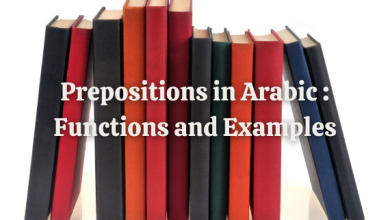Have you ever wondered how Arabic sentences are structured? Do you find yourself puzzled by the word order in Arabic? Understanding Arabic word order can seem daunting at first, but it’s like solving a puzzle – once you grasp the basics, everything starts to fit into place. This guide will walk you through the essential rules and patterns, making Arabic word order simple and approachable.
What is Word Order?
Word order refers to the arrangement of words in a sentence to convey a specific meaning. In English, we typically use Subject-Verb-Object (SVO) order, like “The cat (Subject) eats (Verb) the mouse (Object).” But Arabic has its own unique patterns that can vary depending on the context.
Basic Sentence Structure
In Arabic, the most common sentence structure is Verb-Subject-Object (VSO). This means that the verb usually comes first, followed by the subject and then the object. For example:
- يأكل القط الفأر (Ya’kul al-qat al-far): “The cat eats the mouse.”
Verb-Subject-Object (VSO)

The VSO order is predominant in Arabic. Here’s a breakdown:
- يكتب (Yaktub) means “writes.”
- الطالب (al-Talib) means “the student.”
- رسالة (Risala) means “a letter.”
Combining these in VSO order:
- يكتب الطالب رسالة (Yaktub al-Talib risala): “The student writes a letter.”
Subject-Verb-Object (SVO)
While VSO is common, Arabic can also use the Subject-Verb-Object (SVO) structure, especially in informal speech or to emphasize the subject. For example:
- الطالب يكتب رسالة (al-Talib yaktub risala): “The student writes a letter.”
Object-Verb-Subject (OVS)
In some cases, especially for emphasis or poetic effect, Arabic might use Object-Verb-Subject (OVS). For instance:
- رسالة يكتب الطالب (Risala yaktub al-Talib): “A letter, the student writes.”
Word Order in Questions
When forming questions, the word order can shift. For example:
- هل يكتب الطالب رسالة؟ (Hal yaktub al-Talib risala?): “Is the student writing a letter?”
The particle هل (Hal) is used to indicate a yes/no question, and it typically appears at the beginning of the sentence.
Word Order with Adjectives
Adjectives in Arabic usually follow the noun they describe, maintaining a Noun-Adjective order. For example:
- كتاب جميل (Kitab Jamil): “A beautiful book.”
- بيت كبير (Bayt Kabir): “A big house.”
Word Order with Adverbs
Adverbs can be flexible in Arabic, often placed at the end of a sentence for emphasis. For example:
- يقرأ الطالب بسرعة (Yaqra’ al-Talib bisur’a): “The student reads quickly.”
Negation and Word Order
Negating sentences in Arabic involves using particles like لا (la) for present tense and لم (lam) for past tense. The word order typically remains the same, but the negative particle is placed before the verb:
- لا يكتب الطالب رسالة (La yaktub al-Talib risala): “The student does not write a letter.”
- لم يكتب الطالب رسالة (Lam yaktub al-Talib risala): “The student did not write a letter.”
Emphasis in Arabic Sentences

Arabic allows for various ways to emphasize parts of a sentence. One method is through word order, placing the element to be emphasized at the beginning:
- الطالب يكتب رسالة (al-Talib yaktub risala): “The student writes a letter.” (emphasizing the student)
- رسالة يكتب الطالب (Risala yaktub al-Talib): “A letter, the student writes.” (emphasizing the letter)
Common Mistakes to Avoid
When learning Arabic word order, it’s easy to fall into common traps. Here are a few to watch out for:
- Misplacing adjectives: Remember that adjectives follow the nouns they describe.
- Ignoring verb agreement: Ensure verbs agree in gender and number with their subjects.
- Overusing SVO order: While acceptable, over-reliance on SVO can sound unnatural in formal Arabic.
Practical Exercises
To solidify your understanding of Arabic word order, try these exercises:
- Convert the following SVO sentences to VSO:
- الطالب يقرأ كتابا (al-Talib yaqra’ kitaban) – “The student reads a book.”
- المعلم يشرح الدرس (al-Mu’allim yashrah al-dars) – “The teacher explains the lesson.”
- Form questions from these statements:
- الطفل يلعب في الحديقة (al-Tifl yal’ab fi al-Hadiqa) – “The child plays in the garden.”
- الطبيب يعالج المريض (al-Tabeeb yu’alij al-mareed) – “The doctor treats the patient.”
Summary and Key Points
Mastering Arabic word order involves understanding the flexibility and rules that govern sentence structure. The key points to remember are:
- Arabic commonly uses VSO order.
- Adjectives follow the nouns they describe.
- Questions and emphasis can alter word order.
- Practice through exercises helps solidify these concepts.
Conclusion
Understanding Arabic word order is essential for mastering the language. While it may seem complex at first, with practice and familiarity, it becomes second nature. Whether you’re constructing simple sentences or delving into more complex structures, these guidelines will help you navigate Arabic syntax with confidence.
FAQs
What is the most common word order in Arabic? The most common word order in Arabic is Verb-Subject-Object (VSO).
How do adjectives fit into Arabic word order? Adjectives in Arabic follow the noun they describe, forming a Noun-Adjective order.
Can Arabic sentences start with the subject? Yes, especially in informal speech or for emphasis, Arabic sentences can start with the subject using Subject-Verb-Object (SVO) order.
How does negation affect word order in Arabic? Negation involves placing a negative particle before the verb, while the overall word order remains the same.
Are there exercises to practice Arabic word order? Yes, practical exercises such as converting SVO to VSO sentences and forming questions from statements can help practice Arabic word order.
By understanding these rules and practicing regularly, you’ll gain confidence in using Arabic word order effectively in your conversations and writings.




